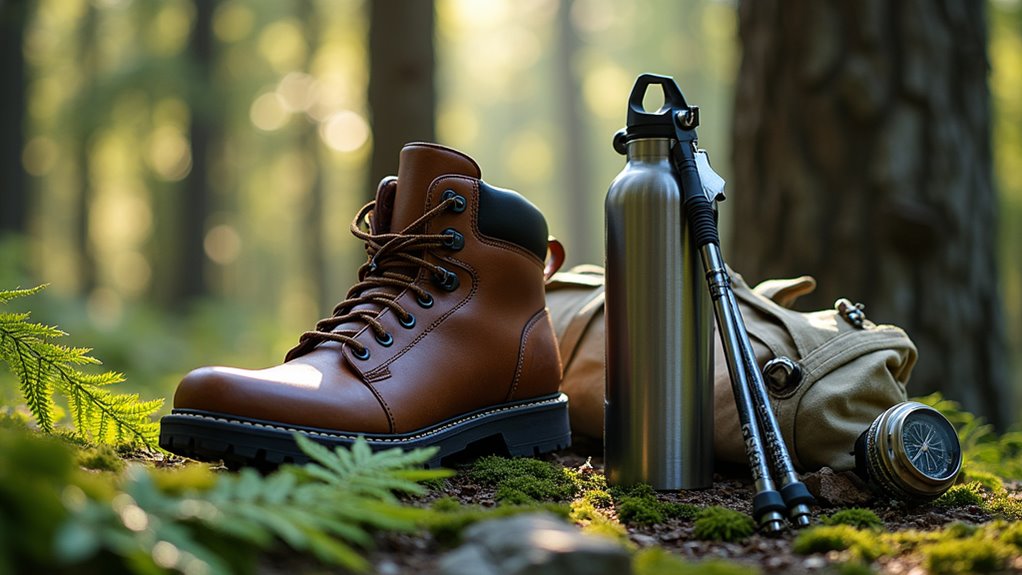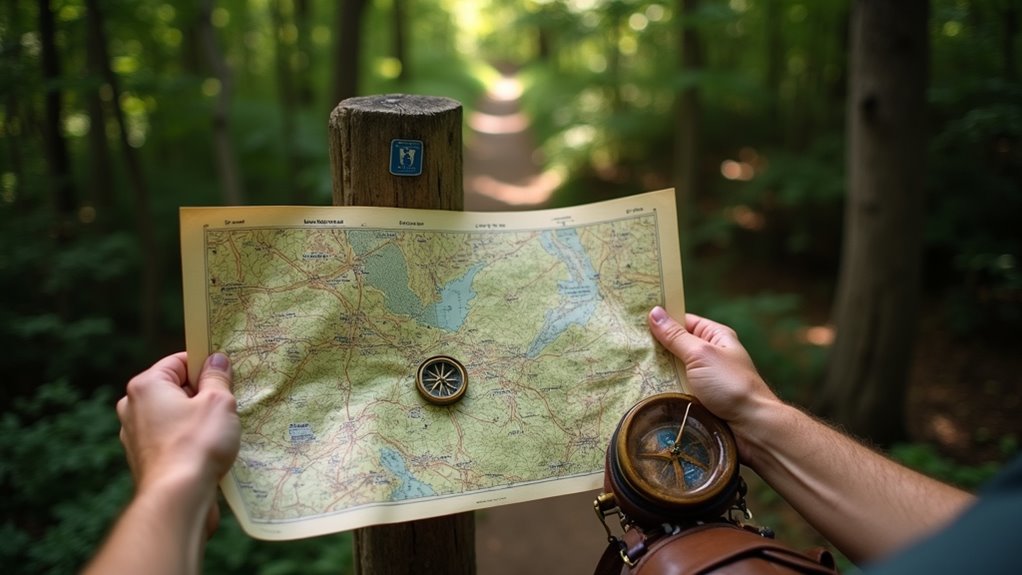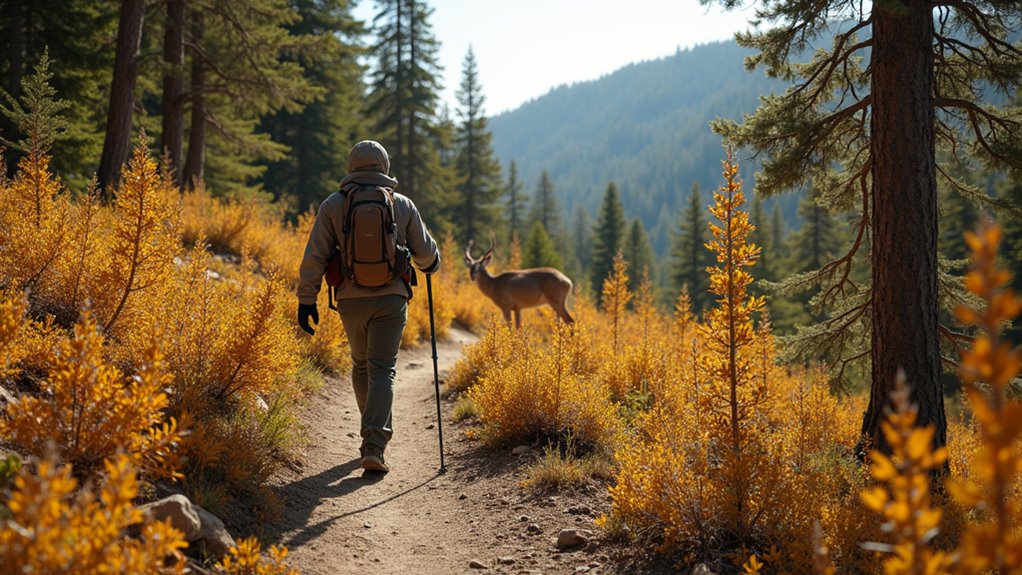Physical Address
304 North Cardinal St.
Dorchester Center, MA 02124
Physical Address
304 North Cardinal St.
Dorchester Center, MA 02124

Hiking country trails demands mastering weather reading, respecting local customs, and preparing for sudden changes that separate authentic adventurers from casual walkers.
Even if you think country hiking is just about walking on dirt paths, you’re missing the deeper art of moving through rural landscapes with genuine respect and skill. You’ll discover that successful country hiking isn’t about conquering terrain—it’s about reading the subtle language of weather patterns, understanding local customs, and preparing for conditions that can shift dramatically within hours. Master these fundamentals, and you’ll transform ordinary countryside walks into profound adventures that connect you authentically with both nature and community.

Before you set foot on those winding country trails, you’ll need the right gear to make your adventure both safe and enjoyable. Start with sturdy hiking boots that’ll grip muddy farm paths and rocky terrain. Pack a lightweight backpack with essentials: water bottles, energy snacks, first-aid kit, and a reliable map or GPS device.
The right gear transforms a risky country hike into a safe, enjoyable adventure through muddy paths and rocky terrain.
Don’t forget weather-appropriate clothing—layers work best since country weather changes quickly. A headlamp beats fumbling with your phone’s flashlight when dusk approaches unexpectedly.
Country trails often lack cell service, so inform someone about your route beforehand. Carry a whistle for emergencies and consider trekking poles for steep sections. Local farmers appreciate hikers who respect their land, so pack out everything you bring in.
Quality gear isn’t just about comfort—it’s your safety net in remote countryside areas. Consider incorporating elements from church camp experiences that emphasize community preparedness and shared responsibility for group safety during outdoor adventures.
While your hiking boots and backpack form the foundation of any trail adventure, understanding seasonal patterns and weather conditions determines whether you’ll have a memorable hike or a miserable ordeal. Check weather forecasts 48 hours before departure, but don’t rely solely on apps—local farmers and park rangers know regional microclimates best.
Spring brings unpredictable storms and muddy trails, while summer demands early starts to beat afternoon thunderstorms. Fall offers ideal conditions but shorter daylight windows. Winter hiking requires specialized gear and avalanche awareness in mountainous areas.
Always pack layers regardless of season—country weather changes rapidly. Monitor barometric pressure drops, which signal incoming storms. Most importantly, develop flexibility in your plans. Experienced hikers know when to turn back, postpone, or choose alternative routes based on evolving conditions.
For those seeking alpine adventures, destinations like Bear Lake in Colorado’s Rocky Mountain National Park showcase how high-altitude environments can present rapidly changing weather conditions even during peak hiking season.

Beyond reading weather patterns, you’ll need to master the art of reading the landscape itself. Country trails aren’t always clearly marked like suburban paths. Look for worn ground, broken twigs at shoulder height, and cairns—those strategic rock piles that locals stack as waypoints.
Your phone’s GPS won’t always work in remote valleys, so carry a physical map and compass. Learn to identify natural landmarks: distinctive rock formations, creek bends, or lone trees.
Many country folk still navigate by “the old oak past Miller’s fence” rather than coordinates. Practice triangulation using visible peaks or ridges.
Pay attention to how locals describe directions—they’ll often reference family properties or historical markers that won’t appear on standard maps.
When you’re ready to establish a basecamp for extended hiking adventures, consider setting up caravan camping sites that allow you to explore multiple trail systems from a single comfortable location.
When you’re miles from the nearest cell tower, a twisted ankle or sudden storm can turn a pleasant hike into a serious situation. Always tell someone your planned route and expected return time—it’s your lifeline if things go wrong.
Pack the ten essentials: navigation tools, sun protection, insulation, illumination, first-aid supplies, fire starter, repair kit, nutrition, hydration, and emergency shelter.
Learn basic wilderness first aid before you need it. Know how to treat sprains, cuts, and hypothermia.
Carry a whistle—three sharp blasts signal distress.
If you’re lost, stop, think, observe, and plan rather than wandering further.
Weather changes fast in rural areas. Check forecasts, but prepare for the unexpected.
Turn back if conditions deteriorate—mountains and trails will wait for another day.
If you’re hiking with a four-legged companion, remember that camping with dogs requires additional safety considerations to protect both you and your pet in the wilderness.

As you venture into the countryside, you’re entering spaces shared by wildlife, fellow hikers, and local communities who’ve stewarded these lands for generations. Respect their legacy by following Leave No Trace principles—pack out everything you bring in, stay on designated trails, and avoid disturbing vegetation or wildlife.
Honor the generations who’ve cared for these lands by treading lightly and leaving only footprints behind.
Keep noise levels down; many hikers seek nature’s tranquility. When encountering others, offer friendly greetings and yield appropriately—uphill hikers have right-of-way, and mountain bikers yield to everyone.
If you’re hiking with dogs, keep them leashed and clean up after them.
Support local economies by purchasing supplies from nearby towns rather than chain stores. Ask landowners for permission before crossing private property, and always close gates behind you. Your thoughtful behavior preserves these treasured landscapes for future generations.
These principles of outdoor respect extend beyond hiking to all wilderness activities, so remember that proper camping etiquette ensures everyone can enjoy nature’s beauty responsibly.
Country hiking demands more from your body than casual neighborhood walks, so building your physical foundation becomes essential for enjoying those rolling hills and extended backcountry adventures. You’ll need cardiovascular endurance, leg strength, and core stability to tackle uneven terrain confidently.
Start conditioning at least six weeks before your planned hikes. Focus on activities that mimic hiking’s demands:
Don’t neglect flexibility work either. Regular stretching prevents muscle tightness that often sidelines weekend warriors during longer country expeditions. Plus, mastering essential camping hacks will complement your physical preparation by ensuring you’re well-equipped for overnight backcountry adventures.
You’ll transform ordinary walks into extraordinary adventures when you combine proper preparation with respect for nature. Take Sarah’s experience in Vermont’s Green Mountains—she packed layers, studied topographic maps, and informed her family of her route. When unexpected fog rolled in, her compass skills and emergency whistle helped her navigate safely back. By following these principles, you’re not just hiking; you’re joining a community of responsible outdoor enthusiasts who cherish and protect wild spaces.